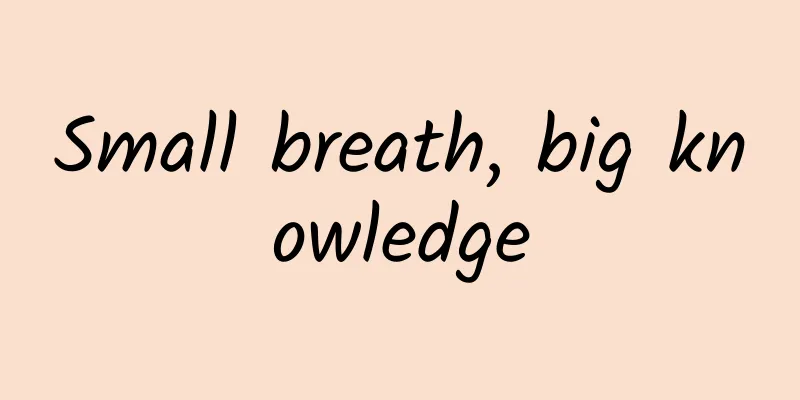Small breath, big knowledge

|
Have you ever had this experience: you are in good health but you get out of breath after walking a few steps, you get tired and anxious easily, and you can’t go up and down the stairs without the elevator. Even if you have the habit of physical exercise, it doesn’t improve. That may be a problem with your breathing. Let’s take the most common example - running with a stitch in the side. When running, the muscles of the whole body quickly enter a state of tension, the body’s oxygen demand increases, but our heart and lung functions cannot keep up, and the breathing is not done properly. The energy for muscle contraction and the supply of oxygen cannot be guaranteed. In order to increase the oxygen supply, the frequency of breathing is unconsciously accelerated, making the breathing rapid and shallow, which can easily cause tension in the respiratory muscles and lead to spasms. Stitches are usually caused by spasms in the abdominal muscles, diaphragm or their supporting ligament muscles. Efficient breathing can not only easily absorb sufficient oxygen to improve our performance in exercise, but also promote the health of our body! First, let's take a deeper look at breathing exercises. The lungs themselves do not have the ability to actively expand and contract. The movement of gas in and out of the lungs is driven by the pressure difference between atmospheric pressure and alveolar gas, and the rise and fall of the diaphragm and the expansion and contraction of the chest cavity cause respiratory movements. (1) Inhalation exercise : Inhalation is an active process. The main inspiratory muscle is the diaphragm, which is shaped like a bell and is located between the chest and abdominal cavities, forming the bottom of the chest. When the diaphragm is at rest, it bulges upward. When the diaphragm contracts, the center of the bulge moves downward, thereby increasing the upper and lower diameters of the chest, increasing the volume of the chest and lungs, and producing an inhalation movement. Since the chest cavity is roughly conical in shape, with a smaller upper part and a larger lower part, the diaphragm only needs to drop slightly to greatly increase the volume of the chest cavity. During quiet breathing, the contraction of the diaphragm can increase the volume of the chest cavity equivalent to 4/5 of the total ventilation, so the contraction of the diaphragm plays an important role in lung ventilation. (2) Exhalation exercise : During quiet exhalation, the exhalation movement is not caused by the contraction of the expiratory muscles, but by the lungs' own retraction and pulling the chest cavity to shrink, restoring its volume before the start of inhalation to produce exhalation. Therefore, quiet exhalation is forced movement, while the expiratory muscles participate in contraction during forced exhalation. The abdominal muscles are the main muscles for forced exhalation. When the abdominal muscles contract, they compress the abdominal organs and push the diaphragm upward. On the other hand, they pull the lower ribs downward and inward. Both reduce the volume of the chest cavity and further reduce the chest cavity. At the same time, with the assistance of the internal and external intercostal muscles, the ribs and sternum move downward, and the ribs also rotate inward, reducing the front-to-back and left-right diameters of the chest cavity, which helps produce exhalation. (3) Breathing pattern: ① Abdominal breathing: When the diaphragm contracts and moves downward, the organs in the abdominal cavity are compressed, causing the abdominal wall to protrude. When the diaphragm relaxes, the abdominal viscera return to their original state. ② Thoracic breathing: When you inhale forcefully, the external intercostal muscles contract, the ribs and sternum are lifted upward, and the lower edge of the ribs deflects outward, thereby increasing the anterior-posterior diameter and left-right diameter of the chest cavity. ③ Mixed mode: Usually abdominal breathing and chest breathing exist at the same time, and one of the modes may be dominant. Only when the chest or abdominal movement is restricted can a single breathing mode appear. Now that you understand the simple principles of breathing, come and do breathing exercises with me! (1) Diaphragm relaxation training The trainee sits on a stool, with the fingers of both hands hooked from the lower edge of the ribs to the inner edge of the ribs, gently moving left and right as we breathe, lightly pressing on one point for five seconds and then moving to the middle, do three sets on each side. (2) Breathing expansion training ① The trainer sits on a stool, raises the left upper limb above the head and gently places it on the right ear, presses the right hand gently on the outside of the left ribs, and gently bends the body to the right until the left ribs and abdomen feel stretched, then inhales, trying to inhale the air to the right side, and slowly returns to the right position when exhaling. Then switch sides and do 10 times on each side. ② Back muscle stretching exercise: kneel on the yoga mat, cross your hands and raise them in front of you with your palms facing outwards. When you inhale, bring your lower jaw closer to your chest, push your palms forward, and bulge your back backwards. When you exhale, slowly return your body to the normal position. Do this 10 times. (3) Abdominal breathing The trainee lies flat on the yoga mat, with the hip and knee joints slightly bent, and the waist as close to the ground as possible; put the right hand on the abdomen, and focus the mind on the abdomen to breathe. The ratio of inhalation and exhalation time is roughly 1:1. When inhaling, feel the hand on the abdomen gently lift up, hold for 3-5 seconds, then purse the lips and exhale slowly. When exhaling, the hand on the abdomen slowly drops. Each training lasts 5-10 minutes. When the muscles around our chest are tense, it will cause breathing problems. After proper relaxation and adjustment, the respiratory muscle function can be improved and the gas exchange efficiency can be enhanced. In daily life, you will find that you are not easily tired when running, you are not easily out of breath when going upstairs, you snore less when sleeping, and even your singing becomes better. After understanding breathing training, everyone must be amazed that there are so many mysteries behind simple breathing! However, before doing breathing training, it is best to conduct a professional cardiopulmonary function assessment and then do it under guidance! The popular science content of this platform has been funded by the China Association for Science and Technology's Science Popularization Department's 2022 National Science Literacy Action Project "National Society Science Popularization Capacity Improvement Project-Rehabilitation Science Popularization Service Capacity Improvement Action Plan" |
<<: China Brain Health Day丨Protect your body's "command center" and enjoy a healthy life
>>: Will people who don’t usually catch colds have stronger immunity?
Recommend
Vaginal itching during menstruation
During the menstrual period, some women may feel ...
Can patients with uterine fibroids get pregnant?
Whether patients with uterine fibroids can become...
These are the foods that can prevent radiation, a must-see for office workers
Today's office workers face computers almost ...
I have some bleeding two days after my period?
Menstruation is a normal physiological cycle for ...
Can I jump rope to lose weight during my period?
Many women are not satisfied with their body shap...
How is melasma formed and how to solve it
You can imagine how great an impact chloasma will...
What are the dangers of uterine fibroids?
Among the many gynecological diseases in women, u...
How many of the ten blind spots in preventing and treating COVID-19 do you know?
Omicron has a low toxicity and will not cause sub...
So scary! Why does a woman's vagina suddenly become bigger?
If you see a girl with an Adam's apple on the...
How long does it take to detect pregnancy in urine test?
Women of childbearing age, if they have sex regul...
Will pregnant women gain weight by eating walnuts?
In modern life, women are no longer seen as repro...
How to deal with vulvar itching during pregnancy
After pregnancy, many women will have many proble...
Why do we feel discomfort in our ears during hyperbaric oxygen therapy?
Author: Liu Bo China Rehabilitation Research Cent...
Can I jog to lose weight during my menstrual period?
Women need to pay attention to caring for and reg...









